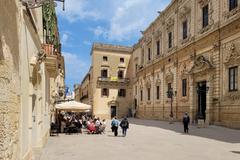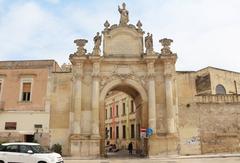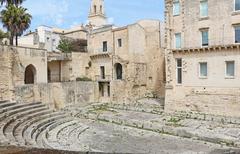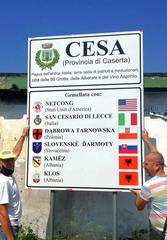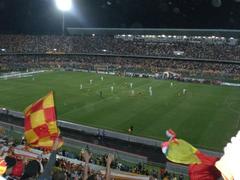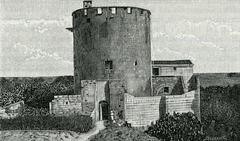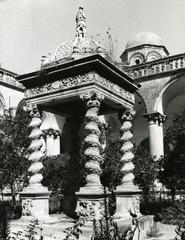Rudiae Lecce, Italy: Visiting Hours, Tickets, and Historical Sites Guide
Date: 15/06/2025
Introduction
Nestled just southwest of Lecce in the Salento region, the Rudiae Archaeological Park stands as a testament to the ancient civilizations that shaped southern Italy. Founded by the Messapians in the late 9th or early 8th centuries BCE, Rudiae is one of the oldest settlements in the area, renowned for its monumental city walls, necropolises, and a grand Roman amphitheater. Over centuries, Rudiae was shaped by Greek, Oscan, and Roman influences, and is celebrated as the birthplace of Quintus Ennius, the father of Latin literature. Today, Rudiae offers visitors a unique journey through time, showcasing well-preserved ruins, guided tours, and cultural events that bring its ancient past to life (Spotting History; Butterfield & Robinson).
This guide provides essential information for visitors, including a historical overview, cultural significance, visiting hours, ticketing, accessibility, travel tips, and nearby attractions. Whether you are a history enthusiast or a curious traveler, Rudiae is a must-see destination in Puglia (Parco Archeologico di Rudiae website).
Table of Contents
- Introduction
- Historical Overview and Archaeological Significance
- Practical Visitor Information
- Key Archaeological Highlights
- Notable Historical Figures
- Nearby Attractions
- FAQ
- Conclusion
- Sources
Historical Overview and Archaeological Significance
Messapian Origins
Rudiae was founded by the Messapians, an ancient Italic people, in the late 9th or early 8th centuries BCE (Wikipedia). The city’s strategic location and its 4-kilometer-long monumental walls made it a crucial center in the Salento region (Comune di Lecce). The remains of these thick tuff and limestone walls bear witness to the city’s early power and defensive needs.
Hellenization and Cultural Blending
By the 6th century BCE, Rudiae underwent significant Hellenization, becoming a melting pot where Messapian, Greek, and, later, Latin cultures mingled. Inscriptions found at the site are in all three languages, reflecting a vibrant, multi-ethnic community. This cultural syncretism is epitomized by the poet Quintus Ennius, who famously claimed to have “three hearts”—Greek, Oscan, and Latin (Spotting History).
Roman Conquest and Urban Development
Rudiae flourished under Roman rule, especially from the 3rd century BCE. The city expanded to about 100 hectares and featured impressive public buildings, including a large amphitheater seating up to 8,000 spectators, paved streets, and extensive necropolises (Wikipedia; The Thinking Traveller). These remains highlight its role as a bustling municipium and rival to neighboring Lupiae (modern Lecce).
Decline
With the rise of Lupiae as a regional urban center, Rudiae gradually declined during the late Roman period. Changing political and economic dynamics led to its reduced significance, but its ruins continue to speak of a once-thriving city (Wikipedia).
Practical Visitor Information
Visiting Hours and Tickets
- Opening Hours: Generally open daily from 9:00 AM to 7:00 PM, with extended hours in summer. Hours can vary by season and event schedule—always confirm via the official website or by phone (+39 349 1186667 / +39 349 5907685).
- Tickets: Standard admission is typically €8, with reduced rates (about €6) for students, seniors, and groups. Children often enter free. Tickets can be bought on-site or in advance online.
- Booking: Guided tours require advanced booking, especially for English-language tours.
Getting There
Rudiae is about 2 km southwest of Lecce’s city center.
- By car: 10–15 minutes from Lecce, with parking near the entrance.
- By bus: Local buses from Lecce stop nearby, but check schedules in advance.
- On foot or bike: A pleasant walk or ride from Lecce through olive groves (Mama Loves Italy).
Accessibility
The park is partially accessible, offering paved paths and an earthen ramp to the amphitheater for visitors with limited mobility. Terrain can be uneven, so sturdy shoes are recommended.
Guided Tours & Special Events
- Guided Tours: Tours typically last 60–90 minutes, available in Italian and (with notice) English. They include multimedia presentations and interpretive panels.
- Events: The park hosts concerts, workshops, and reenactments, especially during the Rudiae Festival and European Heritage Days. Check the website for schedules.
Key Archaeological Highlights
- Roman Amphitheater: Dating to the reign of Emperor Trajan, the amphitheater is partially excavated with visible seating and corridors (vomitoria). It offers a unique, less-crowded alternative to Lecce’s city-center amphitheater.
- Messapian City Walls: Massive stone blocks and defensive ditches illustrate the city’s ancient fortifications.
- Necropolis: Extensive burial chambers, some with grave goods and decorated pottery.
- Other Remains: Roman roads, residential buildings, and places of worship.
- Museums: Artifacts from Rudiae are displayed at the Museo Provinciale Sigismondo Castromediano in Lecce.
Notable Historical Figures
- Quintus Ennius: Born in Rudiae, Ennius (239–169 BCE) is regarded as the father of Roman poetry. His multicultural background mirrored Rudiae’s historical role as a crossroads of civilizations (Wikipedia).
Nearby Attractions
- Lecce Historic Center: Baroque churches, Roman amphitheater, and Porta Rudiae, the city’s oldest gate facing ancient Rudiae.
- Museums: Museo Sigismondo Castromediano and Museo Faggiano, both in Lecce, house important artifacts from Rudiae and the region.
- Salento Countryside: Olive groves and scenic bike routes enrich the visitor experience (Maddy’s Avenue).
Frequently Asked Questions (FAQ)
Q: What are Rudiae’s visiting hours?
A: Typically 9:00 AM–7:00 PM, but hours may vary by season and event. Check here for updates.
Q: How much are tickets?
A: Entry is generally €8 (full price), €6 (reduced), with some discounts and free entry for children.
Q: Are guided tours available in English?
A: Yes, but advance booking is recommended.
Q: Is the site accessible for people with disabilities?
A: Accessible paths and ramps are available, but uneven ground may require assistance.
Q: Can I take photos at Rudiae?
A: Yes, photography is permitted; some restrictions may apply during events.
Practical Tips
- Wear comfortable shoes for uneven terrain.
- Bring water and sun protection, especially in summer.
- Check bus timetables if using public transport.
- Book tours in advance for English language or group visits.
- Respect preservation rules by staying on marked paths and not touching ruins.
Visual Resources
- Image 1: “Rudiae archaeological site showing ancient city walls” (alt: Messapian city walls at Rudiae)
- Image 2: “Roman amphitheatre at Rudiae with seating areas” (alt: Rudiae amphitheatre ruins)
- Image 3: “Intricate mosaic floor from Rudiae” (alt: Roman mosaic at Rudiae)
Conclusion
Rudiae Archaeological Park offers a captivating journey through the ancient past of southern Italy, blending Messapian and Roman legacies in a scenic setting just outside Lecce. With accessible visitor facilities, engaging guided tours, and close proximity to Lecce’s historic center, Rudiae is an essential stop for anyone wishing to explore the deep roots of Salento’s culture. For the most up-to-date visiting hours and ticket information, consult the official Rudiae website and download the Audiala app for guided audio tours, news, and interactive resources.
Further Reading and Official Sources
- Comune di Lecce: Parco Rudiae
- Wikipedia: Rudiae
- Spotting History: Rudiae
- Butterfield & Robinson: A Brief History of Lecce
- Maddy’s Avenue: Things to Do in Lecce
- Mama Loves Italy: Lecce City Guide
- GetYourGuide: Lecce Historical Sites
- Parco Archeologico di Rudiae official website
- Museo Provinciale Sigismondo Castromediano
